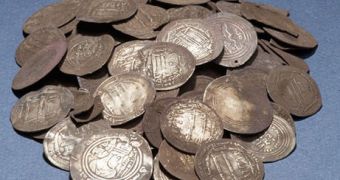Those Vikings were like working bees. A Viking treasure made of 472 ancient silver coins was found near Sweden's main international airport, Arlanda, Stockholm, last week, showing that Vikings used foreign currency much earlier than previously believed.
The 1,150-year-old treasure comprises mainly Arabic coins and it is the largest early Viking hoard ever found in Sweden. The team at the Swedish National Heritage Board discovered the coins while digging a Bronze Age tomb.
"That date (850 AD) is very early, because coin imports (by the Vikings) only start in about 800 AD. The discovery contains more coins than Sweden's only other known large Viking hoard from the period, which was discovered in 1827. That coins were so important to the Vikings at such an early date is very interesting and suggests they may have engaged in intensive overseas trade earlier than previously believed," Kenneth Jonsson, a professor of coin studies at the University of Stockholm, told National Geographic News.
Like most early Viking hoards, this mainly includes Middle East coins, like Arab ones from Baghdad (Iraq) and Damascus (Syria), released in A.D. 840s.
"But the oldest coins came from Persia. These Persian coins must have been in circulation for centuries before being buried and were very high quality," dig team member Karin Beckman-Thoor told National Geographic News.
Most Swedish Viking hoards have been discovered so far on the Baltic island of Gotland, but very few on the mainland.
Once thoroughly studied, the hoard "will give us lots of information about the journey it made and also ideas about why it was left in the ground. The Arlanda airport find might represent either loot from raids or profits from trade," Beckman-Thoor said.
"I think it's 95% trade. Vikings likely exchanged the coins for goods such as slaves, iron, tar, and amber. While Vikings are documented to have traveled as far as the Middle East, most of this overseas trade probably took place in towns in Russia, a country rich in Viking remains. Most of the coins in the newfound hoard had been cut into pieces and the Vikings would have valued them principally for their 95% silver content. They put it on a scale and measured it and the weight gave the value of the silver. They broke it into pieces to get exactly the amount of silver they needed," said Jonsson.
The stone burial chamber, where the treasure was located, was being investigated as a new housing development was going to be raised there.
The Bronze Age tomb has a diameter of 52 ft (17 m) and could be at least one millenium older than the coins. Still, very few Viking tombs bear treasures. "It may be that the prominent burial stones were used as a landmark by Vikings who intended to come back for the silver. Or perhaps they thought their ancestors would protect the hoard, or perhaps it was an offering for their ancestors. The site of a medieval settlement lies below the hill where the stone monument is located. We believe the village goes back to the Viking age," said Beckman-Thoor.

 14 DAY TRIAL //
14 DAY TRIAL //